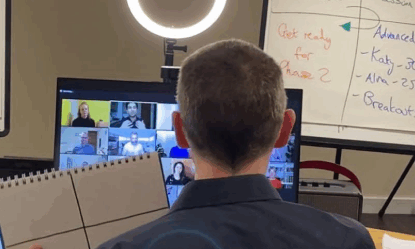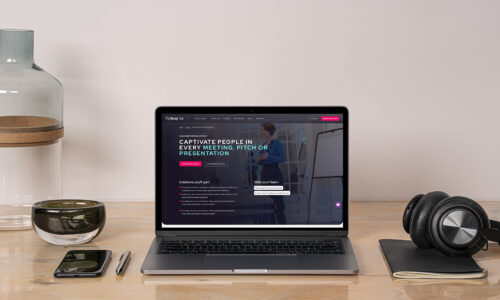“To make it a truly collaborative experience, think about the tech and communication from a virtual perspective first”
How To Run A Hybrid Meeting
In today’s business world, hybrid meetings are becoming more popular. But what is a hybrid meeting, and how can you make sure they run smoothly and everyone is engaged? Here are our top tips if you have to run a hybrid meeting.
DO YOU NEED TO HAVE A HYBRID MEETING?
Hybrid meetings are a new breed, and they take time to plan and prepare. If you’re thinking of bringing differently located people together at short notice, it’s probably best to stick to a Teams or Zoom call. Hybrid meetings only work where everyone has a similar experience and has the opportunity to be heard. If you cannot guarantee equality for all delegates, then a hybrid meeting is not the right choice. So how can we make it inclusive?
THINK DIGITAL FIRST
Ensure everyone is involved in the hybrid meeting process and create an equal playing field between remote and in-person attendees. Often, we revert to the conference room as the primary host and the first point for questions. To make it a truly collaborative experience, think about the tech and communication from a virtual perspective first. It’s easier technically if someone virtually shares the slides and content. If the main host is virtual, they can also automatically mute everyone. This will make it simpler to stop people talking over each other!
PLANNING
Hybrid meetings are hard to manage! As mentioned at the top, you can’t just jump into one; they require planning. An agenda will be essential and will enhance transparency. However, be wary of making agendas too long as they quickly become overwhelming in the actual meeting. Share any materials or presentations ahead of time. It’s good etiquette in meetings regardless, making them more inclusive and accessible to everyone.
MODERATORS
There will be a lot to manage with hybrid meetings. That means it will be more important than ever to have help. If you are presenting live, your co-host or moderator will be virtual. And vice versa. This will build accountability for both audiences and ensure that the technology works well in both the office and the virtual setting.
TIME
Think about how long the meeting should be. Ideally, hybrid meetings should be short, and not last more than an hour. If they need to be longer, take 10-minute breaks every 60 minutes. Speedy meetings are becoming popular amongst businesses, although this doesn’t mean you rush through the agenda! Instead, you finish within 50 minutes giving everyone some time back in their day or the opportunity to have a short break ahead of their next meeting.
TECH
A hybrid meeting may be ruined by poor technology, so it’s critical to check that all of your attendees can be seen and heard. Virtual attendees should have their cameras on and use a decent microphone. Laptop microphones and Bluetooth or cabled headsets often distort the voice and create an echo. A lavelier mic or clip mic is a good choice, which helps your voice sound clear and crisp. What about if you’re in the conference room? Some offices have Zoom or Teams-enabled rooms with cameras and microphones that help focus attention on the person speaking. If this is not available, you might want to invest in a 360-degree conference camera. When people in the room are only using laptops, make sure they mute their microphones. Otherwise, you’ll get feedback echoing around the room – and we all know it’s impossible to concentrate when that happens!
ENGAGEMENT
This has always been a challenge in the world of virtual meetings and it’s the same for hybrid. Often an audience drifts off because they’re bored, or they don’t feel there’s a benefit for them to be there. You also get a lack of engagement through some of the previously mentioned tech issues. Keeping slides visual and simple is a good place to start, and of course, make sure everyone can see them. Online interactive platforms like Menti means everyone can be involved using their smartphones, it’s also a good choice if not everyone has access to the chatbox. Using Menti for people to comment could be a more collaborative choice allowing everyone to have a voice. Interactive whiteboards are another great way to create engagement. A digital version will generally be better than a flip chart in the conference room so everyone can contribute.
EYE CONTACT
Eye contact has always been a vital part of communication; it’s the difference between having a conversation instead of listening to a boring presentation. But how do you make strong eye contact in a hybrid environment? The most common mistake people make when attending in person is to look at the screen to talk to the remote delegates. If you think about it, though, this means the remote delegates never get any proper eye contact! If you’re in the conference room, make eye contact with those next to you AND the camera. It will take some practice, but your remote colleagues will thank you for it. From the other perspective, if you’re joining remotely, you also need to talk to the camera and not to your slides or second screen.
We’d love to help you and your team have successful hybrid meetings this year! Check out our popular masterclass for more inspiration.

















